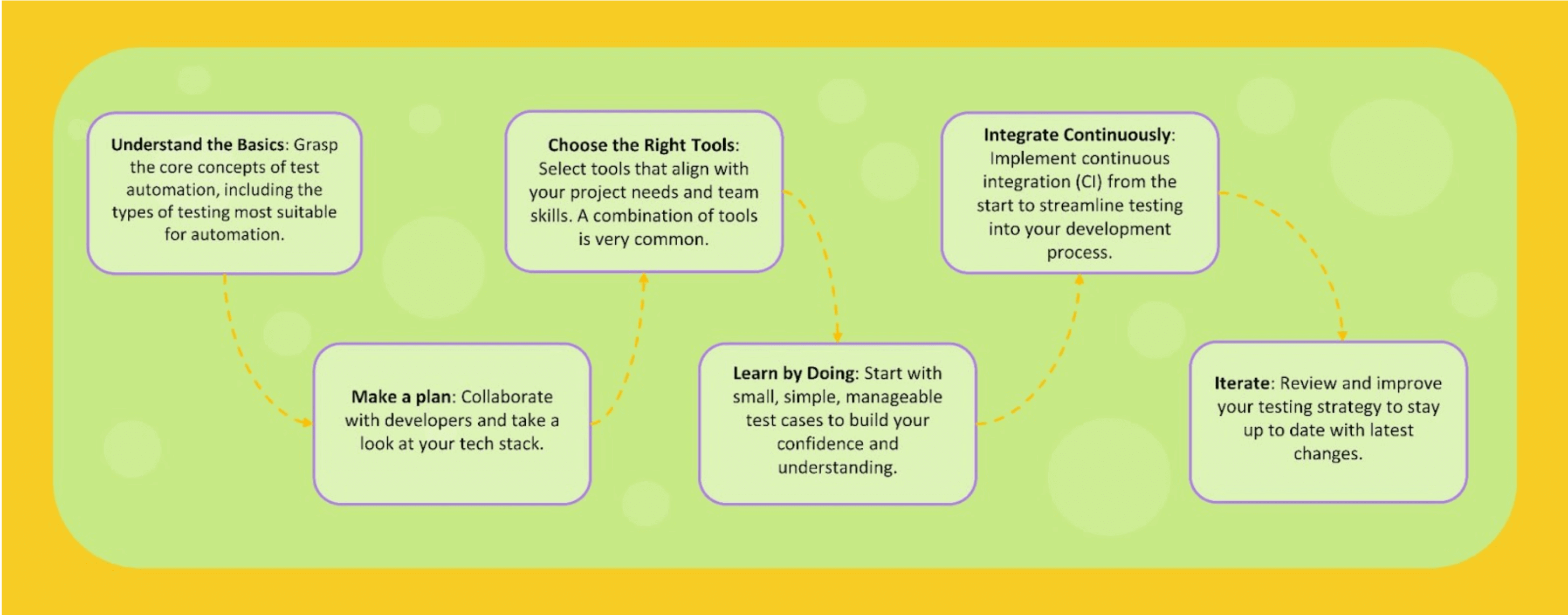Starting Test Automation Journey: A Guide for Newcomers
May 14, 2024

Maryia Tuleika, a Lead test automation consultant, specializes in backend testing and embedded systems. She's an active community member, contributing to the growth of new test professionals.
She shares her insights on international platforms and local gatherings, building a LinkedIn testing community. Follow her insights under the hashtag #TechWithMaryia.
Starting Test Automation Journey: A Guide for Newcomers
Test automation offers numerous benefits, and by following best practices for automated testing, you can ensure that testing strategy offers the highest return on investment (ROI). Automated testing can streamline development cycles, eliminate repetitive tasks, and enhance software quality. But how do you start?
This article will guide you through the foundational steps necessary to start your test automation journey effectively.

Step 1: Understand the Basics
Before diving into test automation, it’s essential to grasp the core concepts and understand what test automation can and cannot do. Familiarize yourself with the basic terminology, the differences between manual and automated testing, and the common challenges you might face. This foundational knowledge will help you make informed decisions throughout your automation journey.
Step 2: Make a Plan
Effective test automation begins with a solid plan. Define clear objectives for what you aim to achieve—be it faster testing cycles, improved test coverage, or early detection of defects. Determine which tests are the best candidates for automation, typically those that are repetitive or prone to human error. Outline how you’ll measure the success of your automation efforts, considering factors like test stability, coverage, and maintenance overhead.
Step 3: Choose the Right Tools
Selecting appropriate tools is critical to your success in test automation. Consider the language and framework your development team uses, the compatibility with your existing tech stack, and the specific needs of your project. Tools like Selenium, Cypress, and Playwright offer different features that may be more suited to certain testing environments than others. Also, take into account the community support and learning resources available for these tools.
Step 4: Learn by Doing
The best way to master test automation is through hands-on experience. Start with simple test cases to understand how your chosen tools work. Gradually increase the complexity of your tests as you become more comfortable. Use this phase to experiment with writing, executing, and debugging tests. This practical experience is invaluable and will solidify your understanding of automated testing practices.
Step 5: Integrate Continuously
Integrate your automated tests into your Continuous Integration/Continuous Deployment (CI/CD) pipeline. This integration ensures that tests are run automatically every time there is a change in the codebase, helping to catch issues early and often. Continuous integration of testing helps in maintaining the health of your software, reducing the risk of bugs making it to production.
Step 6: Iterate
Test automation is not a set-it-and-forget-it process. As your application evolves, so should your tests. Regularly review and update your tests to cover new features and changes in the application. Also, continuously assess the effectiveness of your test automation strategy and make adjustments as needed. This iterative process helps ensure that your test automation efforts remain aligned with your project goals and continue to deliver value.
Conclusion
Starting with test automation can seem daunting, but by understanding the basics, planning carefully, choosing the right tools, and continuously iterating, you can establish a robust automation strategy that significantly enhances your software development lifecycle. Remember, the key to successful test automation is not just in the tools you choose but in the continuous learning and adaptation of your approach to fit the changing needs of your software projects. Jump on this journey with a focus on incremental improvement, and watch your development process transform.